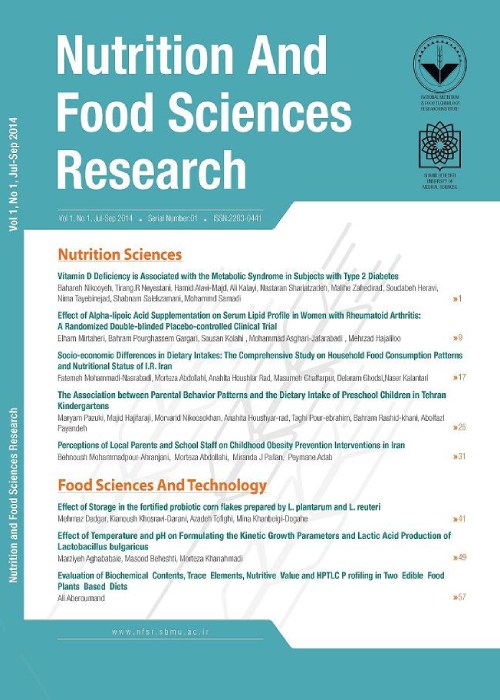Melissa officinalis Essential Oil: Chemical Compositions, Antioxidant Potential, Total Phenolic Content and Antimicrobial Activity
Author(s):
Article Type:
Research/Original Article (دارای رتبه معتبر)
Abstract:
Background and Objectives
Melissa officinalis belongs to plant Lamiaceae family and is native to Iran as well as other countries. The aim of this study was to identify chemical compositions and antioxidant activity of the M. officinalis essential oil (EO). Another aim of this paper was to assess antimicrobial activity of M. officinalis EO on growth of clinical and commercial strains causing infection.
Materials and Methods
Chemical compositions of the M. officinalis EO were analyzed using gas chromatography-mass spectrometry (GC-MS). The antioxidant potential was assessed using β-carotene/linoleic acid inhibition and 2,2-diphenyl-1-picrylhydrazyl methods. The total phenol content was analyzed using Folin-Ciocalteu method. Antimicrobial activities of the M. officinalis EO were assessed using disk diffusion agar, well diffusion agar, micro-well dilution, agar dilution and minimum bactericidal concentration (MBC) methods.
Results
Major compositions of the M. officinalis EO included geranyl acetate (27.9 %), citral (14.2%), Z-citral (9.8%) citronellal (8.4%) and citronellol (7.6%). The total phenolic content and antioxidant potential of the M. officinalis EO included 51 ±0.50 mg GAE/g and 98 ±0.45 µg/ml, respectively. Minimum inhibitory concentration (MIC) of the M. officinalis EO ranged 0.5–4 mg/ml, while the MBC ranged 1–8 mg/ml. A significant correlation was seen between the inhibition zone diameters (IZD) and concentration of the EO. The smallest IZD was reported for various concentrations of the M. officinalis EO on Pseudomonas aeruginosa.
Conclusions
In general, results showed that the M. officinalis EO included greater inhibitory effects on commercial bacterial strains causing infections, compared to those of clinical bacterial strains. The M. officinalis EO have the greatest effect on gram-positive bacteria. This compound is an effective free radical scavenger rich in phenolic compounds. Further studies are necessary to investigate toxicity of the M. officinalis EO due to its safety for human useKeywords:
Language:
English
Published:
Nutrition & Food Technology Research, Volume:6 Issue: 1, Jan-Mar 2019
Pages:
17 to 25
https://magiran.com/p1930690
دانلود و مطالعه متن این مقاله با یکی از روشهای زیر امکان پذیر است:
اشتراک شخصی
با عضویت و پرداخت آنلاین حق اشتراک یکساله به مبلغ 1,390,000ريال میتوانید 70 عنوان مطلب دانلود کنید!
اشتراک سازمانی
به کتابخانه دانشگاه یا محل کار خود پیشنهاد کنید تا اشتراک سازمانی این پایگاه را برای دسترسی نامحدود همه کاربران به متن مطالب تهیه نمایند!
توجه!
- حق عضویت دریافتی صرف حمایت از نشریات عضو و نگهداری، تکمیل و توسعه مگیران میشود.
- پرداخت حق اشتراک و دانلود مقالات اجازه بازنشر آن در سایر رسانههای چاپی و دیجیتال را به کاربر نمیدهد.
In order to view content subscription is required
Personal subscription
Subscribe magiran.com for 70 € euros via PayPal and download 70 articles during a year.
Organization subscription
Please contact us to subscribe your university or library for unlimited access!


